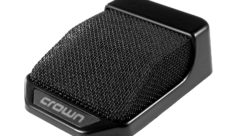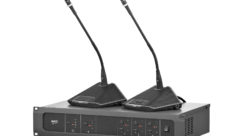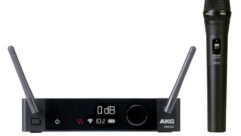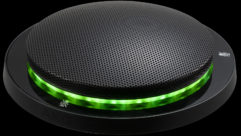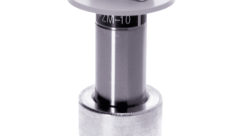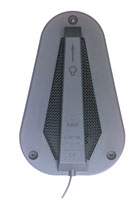

Boundary Mics and Automatic Mixers
Sep 15, 2010 12:12 PM,
By Mark Johnson
Automatic mixers and boundary mics go hand in hand (or at least XLR to XLR). Boundary mics can be used in many of the applications where you would also want to employ an automixer—situations where it might not be practical to use a full-time system operator, especially in meeting places such as a conference space, boardroom, or courtroom. Other typical uses can even include houses of worship. As you’ll see, many of the manufacturers produce mics as well as mixers. And there are more choices than you might imagine with quite a few options available for styles and types and, for automatic mixers, performance algorithms.
Boundary Layer Microphones: The Basics
One of the biggest advantages of a boundary microphone design is the reduction of comb-filtering effects. This occurs by greatly increasing the ratio of direct sound versus reflected and ambient sounds the mic picks up. This is accomplished by placing the mic element near a boundary surface such as a floor wall or tabletop.
As a contrast, consider a typical stand-mounted microphone we’re all so familiar with. For distance-miking applications, the sound will arrive at the mic element via two different paths: direct sound and sound reflected off a surface such as a wall, floor, or tabletop. The path of the reflected sound is longer than the direct sound, so the reflected sound arrives slightly later and is delayed at the microphone. The result of the delayed sound combining with the direct sound is called “comb filtering” because when it’s displayed on an analyzer, the response looks like the spiked teeth of a comb.
Boundary layer microphones are designed to take advantage of a fixed surface such as a wall, floor, or ceiling. By positioning the mic element close to the boundary, the reflected sound entering the mic is minimized.
Boundary mics can come in a few different form factors. One implementation is small condenser elements that protrude just slightly over the surface of a table, lectern, ceiling, or wall, facing outward. These are also called button mics because of their resemblance to small buttons. Other versions place the mic element just above and perpendicular to the boundary surface or just above and parallel to the boundary surface and facing back to it, also called a Pressure Zone Microphone (PZM). Ron Wickersham and Ed Long were granted a patent for the PZM in 1982, which was initially developed by Ken Wahrenbrock and later manufactured by Crown. The common denominator in all three implementations is that the mic element is just above the boundary surface, thereby minimizing the reflection path.
AKG Acoustics C 547 BL
Another advantage of such mic designs is a low, unobtrusive profile that keeps sightlines clean. Boundary mics employ omnidirectional or cardioid pickup patterns and are well-suited for area-miking on a stage or picking up people’s voices around a conference room table or at a lectern. Boundary mics have also found favor as a kick drum mic, positioned just in front of (or inside) a bass drum.
For practical reasons, many boundary mics are affixed to a small plate; however, the low frequency response improves as the size of the boundary increases.
There are dozens of boundary mics on the market in a variety of price ranges. Following is a sampling of some of the boundary mic models available, listed alphabetically.

Audio-Technica ES961
The AKG C 547 BL has a hypercardioid pickup pattern. It features a low-frequency roll-off filter to help reduce foot noise in live stage applications. The 7.3”x4.7”x0.8” (LxWxH) body is designed to be crush-proof and can withstand the weight of an average-sized person stepping on it. The matte black body surface is paintable to blend in with any décor. Its stated frequency response is 30Hz to 18,000Hz. It’s also offered as the C 547 BL-T, a nonwindscreen version designed for tabletop use.

Astatic 930VPL
The Astatic 930VPL features a continuously variable polar response that allows the contractor to set the pickup pattern to meet the specific need of any particular installation. Features include a dual-output connector design that allows the cable to exit the rear or the underside of the microphone, a programmable membrane switch, and a logic interface for interfacing with automatic mixers, teleconferencing systems, and control systems. The frequency response is 40Hz to 15kHz.
The Audio-Technica ES961 has a frequency response of 30Hz to 20,000Hz and features a half-cardioid polar pattern—cardioid in the hemisphere above the mounting surface. Optional, interchangeable omni and hypercardioid elements are available. Features include a PivotPoint rotating output connector and a heavy die-cast base with silicon pads to prevent surface vibration coupling. The mic is also offered as the ES961RC version with an external contact closure that lets users control a local or remote device from the switch on the microphone.

Audix ADX60
The Audix ADX60 features a hemi-cardioid polar pattern with a frequency response of 50Hz to 18kHz. Construction includes a die-cast zinc casing and a steel mesh grille with a low-reflectivity
matte black e-coat finish and mini-XLR connector. The mic has a standard cardioid response, but interchangeable omnidirectional and hypercardioid capsules are also available. Specs include a stated frequency response of 50Hz to 18kHz.
Designed for use with with standard videoconferencing systems, the Beyerdynamic Stegos TB wireless boundary mic features a semicardioid pickup pattern, an illuminated multifunction button (manual or push-to-mute), and a maximum operating time of 14 hours from its rechargeable NiMH batteries. It operates in the 2.4GHz range, and its Spread-Spectrum and 128-bit encryption keying guard against unauthorized listening.

Galaxy Audio BN-273PH
The button-style omnidirectional condenser Clockaudio C003E mic features through-desk mounting and a satin black or matte white finish. The threaded brass body has an overall length of 90mm and accommodates mounting surfaces up to approximately 2.75in. thick. Its frequency response is 20Hz to 20,000Hz. Clockaudio’s C004E is a similar model, but it has a cardioid response and a 100Hz to 16kHz bandwidth.
The stylish DPA Microphones BLM4060 features an omnidirectional hemisphere pickup. It’s constructed of a 4in. diameter stainless steel base with a center black rubber disk that effectively shock-mounts the condenser capsule and eliminates vibration noise. The mic’s response is stated as 20Hz to 14kHz, with a +7dB soft boost at 8kHz to improve vocal intelligibility.

Sennheiser e 912
Part of Electro-Voice’s PolarChoice line, the Boundary Satellite mic features a user-selectable polar pattern (omni, cardioid, supercardioid, or figure-8) and accepts an Electro-Voice or Telex bodypack transmitter for wireless operation. An onboard mute switch can be set to operate as either latching on/off or momentary push-to-mute/push-to-talk, and a high-visibility blue LED clearly displays mic status to the user. Its frequency response is 50Hz to 20,000Hz.
Galaxy Audio’s BN-273PH features a cardioid pickup pattern with a 30Hz to 20kHz response. Recessed DIP switches on the mic’s underside enable users to reset the operation on the top panel on/off button, which is selectable from push-to-talk, push-to-mute, or latching on/off modes, along with a switchable high-pass filter. The BN-273PH has a tough, die-cast zinc body that’s available in black or white finish, and a top-mounted LED glows when the mic is active.
The Sennheiser e 912 features a half-cardioid pickup pattern and a frequency response of 20Hz to 20,000Hz. The e 912 is optimized for instruments, vocals, and speech, and it is available in black or cream. Also offered in gray, the speech-optimized e 912 S is similar, but it features an integrated membrane switch and an internal DIP switch bank providing the following features: on/off, push-to-talk, push-to-mute, or permanently switched on. Additionally, the frequency response of the e 912 S can be changed via a second DIP switch bank, offering low-cut, low/high boost, low boost, or linear.

Shure MX396
Shure’s MX396 multi-element boundary microphone is offered in MX396C/DUAL (dual-element) and MX396/TRI (tri-element) versions that provide a variety of pickup configurations for end-of-table (300-degree), center-of-table (360-degree), or cross-table (bidirectional) coverage patterns. Both feature an individual audio output for each element, a bicolor status indicator, a programmable mute switch, and a logic input/output for remote LED and mute control. Its frequency response is 50Hz to 17,000Hz.
1
Boundary Mics and Automatic Mixers
Sep 15, 2010 12:12 PM,
By Mark Johnson
Automatic Microphone Mixers: Keeping It Under Control
Now that you’ve chosen the mics that fit the needs of your specific application/installation, how do you control them? The situation is especially problematic in a boardroom or conference room environment where having an operator on hand is often not practical—or even desired.
At the most basic level, an automatic mic mixer turns up the specific microphone (or microphones) that are in use, while the remaining mics are off or at a low level, and overall system gain is adjusted to avoid feedback. This can be accomplished with approaches as simple as a noise gate, ranging to adaptive threshold sensing and gain reduction systems. Depending on the manufacturer and model, analog and/or digital circuitry is used. Most of the units available can be linked to provide more input automixing capability.
Dan Dugan is generally acknowledged as the inventor of the automatic mixer, debuting his Dugan System Model A mixer in 1971. Quite a lot has transpired since then, and it’s now a competitive marketplace with a lot of choices. We examined a selection of current offerings that employ divergent approaches to the technology from a variety of manufacturers.

Audio-Technica AT-MX381 SmartMixer
The latest addition to Audio-Technica’s family of automatic mixers, the 8-channel AT-MX381 SmartMixer features three different priority selection/operation modes. Basic functions (such as line/mic input switching, phantom power, gain, and low-cut filters) can be set from the unit itself with more in-depth control available via an RS-232 data post using the included SmartMix PC software. The unit is rackmountable and compatible with Crestron and AMX systems. Up to 16 AT-MX381 units can be linked for up to 128 inputs.
Biamp’s Systems autoTwo is an 8-channel mic/line mixer that features channel 8 mix-minus assign and ducking via channels 1 through 7. The unit also features logic outputs for switching of external circuits, adaptive threshold-sensing speech frequency filtering, and manual priority override. Also standard is selectable channel-off attenuation, selectable last mic hold, and full compatibility with all other Biamp products. Two units can be cascaded for up to 16-input operation.
The ClearOne Converge SR 1212 is an advanced automatic digital mixer with ClearOne’s fourth-generation audio processing technologies. This 12×12 (in/out) automatic digital mixer has eight mic/line inputs and four line inputs. The unit features USB and Ethernet connectivity and drag-and-drop configuration software. Multiple units within the Converge family can be linked for additional flexibility and/or input control, 32 presets can be executed on-the-fly, and 255 macros allow customized audio control and configuration with single command execution.

Clockaudio MR88
The Clockaudio MR88 digital automatic mixer is a DSP microprocessor-controlled, automatic switching, 8-channel microphone mixer that provides eight mic/line inputs, two outputs, and individual unbalanced outputs from each of the mic preamps for recording feeds. The MR88 can be daisy-chained with other MR88 mixers when more than eight microphones are required to create a multimixer system, or the system can function as a standalone 8×2 mixer. Input channels can be set to a multilevel priority system, allowing for one-at-a-time operation, all channels active, or combinations with chairman priorities.
The Dan Dugan Sound Design D-2 automatic mixing controller is designed for insertion into up to eight channels on a mixing console to use the functions of the mixer while taking advantage of the controller’s automatic mixing capabilities. The system is composed of a 2RU processor with all the I/O connections and a separate mix control panel. The D-2 combines three patented technologies—the Dugan Speech System, the Dugan Music System, and the Dugan Gain Limiting System—to provide transparent mic control under nearly any situation. Built-in expandability allows linking units for up to 64 channels.
The Lectrosonics DM84 digital matrix processor is an eight-in/four-out automatic matrix mixer. Each input has six filters and six feedback eliminators, with compression and delay available. Other features include eight mic/line inputs and four mic/line outputs; switchable phantom power; programmable front-panel control knobs for easy I/O gain adjustment; input and output channel activity indicators; and automatic mic mixing with proportional gain and autoskew. The unit is AMX- and Crestron-compatible with USB and RS-232 interfaces for setup and control.
The Peavey Architectural Acoustics Automix Control 8 offers eight transformer balanced mic/line inputs. The first two channels feature a priority control and each channel has a phantom power (on mic inputs), low-cut filter, aux send control, and can be set for manual and auto operation. Each channel also has an insert point and 5V TTL status output. Multiple channels can be muted simultaneously via an assignable mute bus. Several units can be linked to form a single mixer with 16, 24, 32, or more inputs, and the Automix Control 8 includes a see-through Plexiglas security panel to prevent unauthorized changes.

Rane AM1
Part gain-sharing automatic mic mixer, part manual line mixer, part USB audio I/O device, the Rane AM1 is a 4-channel unit that features additional aux inputs as well as USB I/O. Each of the four XLR mic inputs offers level controls feeding a gain-sharing automatic mixer, or it can be used as a standalone mic mixer. Expansion for more gain-shared mics is possible using up to seven Rane AM2 automixers, and a RAD port allows transport the main mix via a Rane Mongoose to a CobraNet network. The AM1 shows up as a standard USB audio device on Windows and Apple computers and is compatible with many audio recording and playback apps.
The Shure SCM810 8-channel automatic microphone mixer features noise adaptive threshold to distinguish between constant background noise and audio signal fluctuating in pitch, level, and consistency (speech). All inputs are balanced and provide phantom power for condenser mics. Low-cut filter and high-shelving EQ is provided on all input channels along with direct outputs on each mic/line input as well as a peak responding output limiter with selectable thresholds on the main output. Seven position-programmable switches offer further tweaks to internal features, and the mixer can be switched between manual and automatic modes.

TOA Electronics D-901
The TOA Electronics D-901 is a modular 12-input, eight-bus, eight-output system with a variety of input modules available and RS-232 or contact-closure remote control. EQ and filter settings can be saved in up to 16 internal memories and the unit can be controlled using AMX or Crestron devices. Onboard processing tools include automixing, feedback suppression, multiband parametric EQ, compressors/limiters, gates, crossovers, and delays. The D-201 is programmable from the front panel or using included PC control software and can be set up and preconfigured offsite and updated onsite.
Mark Johnson has been involved with audio and video for more than 35 years, including production, manufacturing, and covering the industries for various publications.
2


